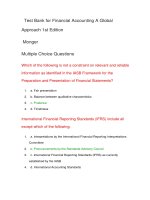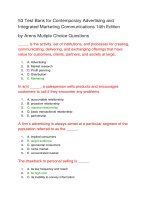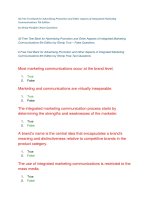Test bank for forensic accounting and fraud examination 1st editio
Bạn đang xem bản rút gọn của tài liệu. Xem và tải ngay bản đầy đủ của tài liệu tại đây (152 KB, 17 trang )
Test Bank for Forensic Accounting and Fraud Examination 1st
Editio
Which statement below correctly states the four elements required to prove
larceny?
1. A. There must be a taking or carrying away of the money of another without
the consent of the owner and with the intent to deprive the owner of its use.
2. B. There was a taking or carrying away, of the money or property of another
without the consent of the owner, and with the intent to deprive the owner of
its use or possession.
3. C. There was a carrying away, of the property of another without the consent,
and with the intent to deprive the owner of its possession.
4. D. There was a taking or carrying away, of the property of another with the
intent to deprive the owner of its use or possession.
The tort, known as conversion is correctly stated as:
1. A. the taking of property of another with the intent to deprive the owner of its
use or possession.
2. B. an assumption and exercise of the right of ownership over goods or
personal chattels belonging to another.
3. C. the carrying away of the property of another without the consent of the
owner.
4. D. an unauthorized assumption and exercise of the right of ownership over
goods or personal chattels belonging to another, to the alteration of their
condition or the exclusion of the owner’s rights.
A person is said to act in a ‘fiduciary capacity’ when:
1. A. the business which he transacts, or the money or property which he
handles, is not for his own benefit.
2. B. a relationship exists between the defendant and the plaintiff.
3. C. the action resulted in harm to the defendant.
4. D. he stands in a relation implying normal confidence, trust, and faith.
Practically speaking, the law generally recognizes a fiduciary duty:
1. A. for cashiers and accountants.
2. B. for ordinary employees handling cash and valuables.
3. C. for officers and directors of a company.
4. D. All of the above are recognized as having a fiduciary duty.
Which of the following acts would not be considered an abuse or abusive?
1. A. Surf the Internet while at work.
2. B. Remove small amounts of cash from the cash register till.
3. C. Taking a long lunch or break.
4. D. Using sick leave to see a child’s play at school.
An employee enters the work place on a day off and utilizes the leased
plotter/printer for four hours to produce graphics for his child’s school play.
The lease payment is $80 per hour and his wages are $20 per hour. Select the
correct statement from the choices below.
1. A. This is an abuse at the assumed value of $400.
2. B. This is an instance of fraud at the assumed value of $400.
3. C. This is an abuse at the assumed value of $320.
4. D. This is an instance of fraud at the assumed value of $320.
The two primary functions of financial forensics are:
1. A. litigation advisory services and investigative services.
2. B. litigation advisory services and expert witness services.
3. C. post event auditing services and investigative services.
4. D. post event auditing services and expert witness services.
Auditing is responsible for:
1. A. litigation support and redemption.
2. B. risk assessment and internal controls.
3. C. risk assessment and calculation of damages.
4. D. business valuation and risk assessment.
The interrelationship among auditing, fraud examination, and financial
forensics is:
1. A. established and maintained by legal structures and justice processes.
2. B. constant even while social and cultural pressures are exerted on it.
3. C. based on the SOX Act and SAS 99.
4. D. dynamic and changes over time.
Select the most correct statement from those below.
1. A. Timing – Recurring for auditing and fraud examination, nonrecurring for
financial forensics.
2. B. Objectives – Opinion for auditing and financial forensics, affix blame for
fraud examination.
3. C. Relationship – Nonadversarial for auditing, adversarial for fraud
examination, and independent for financial forensics.
4. D. Methodology – Audit techniques for auditing and financial forensics, fraud
examination techniques for fraud examination.
While a fraud examiner’s objective is to determine whether fraud has
occurred and who is likely responsible, the financial forensics investigator’s
objective is to:
1. A. calculate financial impact based on formulaic assumptions.
2. B. determine whether the allegations are reasonable based on the financial
evidence and, if so, the financial impact of the allegations.
3. C. Gather the required financial and nonfinancial evidence to examine the
allegations independently and determine their financial impact.
4. D. attempt to gather sufficient evidence to support or refute the allegation
and related damages.
According to the ACFE, owners and executives are involved in only about:
1. A. 23 percent of frauds and steal approximately $834,000.
2. B. 40 percent of frauds and steal approximately $834,000.
3. C. 64 percent of frauds and steal approximately $834,000.
4. D. 93 percent of frauds and steal approximately $834,000.
From the list below, create the typical fraud perpetrator profile.
1. A. Male, high school education, young, general labor, and with the company
for years.
2. B. Female, high school education, young, general labor, and relatively new to
the company.
3. C. Male, post secondary education, middle aged, professional, and with the
company for years.
4. D. Female, post secondary education, middle aged, professional, and
relatively new to the company.
The three legs of the fraud triangle are:
1. A. Opportunity, Perceived Pressure, and Rationalization.
2. B. Opportunity, Value, and Rationalization.
3. C. Opportunity, Perceived Pressure, and Benefit.
4. D. Timing, Value, and Benefit.
Financial statement fraud is often attributed to pressures, such as all of the
following except:
1. A. investment losses.
2. B. meeting analysts’ expectations.
3. C. deadlines, and cutoffs.
4. D. qualifying for bonuses.
M/C Fraud deterrence begins:
1. A. with the employer’s internal controls.
2. B. in the employee’s mind.
3. C. with the fraud examination.
4. D. with regulatory and legal actions such as PCAOB Auditing Standard No. 5,
AICPA Statement on Auditing Standards (SAS) No. 99, and the Sarbanes–
Oxley Act.
The acronym “M.I.C.E.” as typical motivations of fraud perpetrators stands
for:
1. A. Money, Ideology, Coercion, and Environment.
2. B. Money, Ideology, Coercion, and Ego.
3. C. Motive, Ideology, Coercion, and Ego.
4. D. Money, Image, Capability, and Environment.
When the losses caused by fraud are correlated to the levels of compensation
of the perpetrator, the line is somewhat linear, with slow rise from low
compensation to approximately:
1. A. $100,000 annually where the rate of loss skyrockets.
2. B. $300,000 annually where the rate of loss skyrockets.
3. C. $500,000 annually where the rate of loss skyrockets.
4. D. $750,000 annually where the rate of loss skyrockets.
As compensation of the perpetrator increases the losses associated with the
perpetrator rise most likely because:
1. A. the perpetrator has a greater appreciation of costly pleasures.
2. B. the perpetrator has greater access to company funds and assets.
3. C. the perpetrator has a higher cost of status and image.
4. D. the perpetrator can coerce others into the scheme.
Small businesses, such as those with less than one hundred employees,
account for approximately what percentage of the cases in the 2006 and 2008
ACFE surveys?
1. A. 10%-14%
2. B. 35%-27%
3. C. 36%-38%
4. D. 50%-52%
Which of the follow is not a reason why small businesses have high losses to
fraud?
1. A. Smaller businesses have fewer personnel doing more jobs.
2. B. Small businesses frequently have external fraud detection units.
3. C. Small businesses frequently have higher degrees of trust between
personnel.
4. D. All of the above are reasons why small businesses have higher fraud
losses.
The most common anti-fraud measure used by respondents to the ACFE’s
National Fraud Survey was:
1. A. the external audit of financial statements.
2. B. a formal code of conduct.
3. C. surprise audits.
4. D. job rotation/mandatory vacation policies.
A common complaint among those who investigate fraud is that:
1. A. the adversarial relationship between plaintiffs and fraud examiners
resulted in weak cases.
2. B. job rotation policies often result in perpetrators being moved to new
positions of responsibility before being exposed.
3. C. companies often conceal the cost of fraud as other business expenses.
4. D. organizations and law enforcement do not do enough to punish fraud and
other white-collar offenses.
In fraud cases where no legal action was taken, the most significant reason
for the lack of prosecution was cited as:
1. A. that internal discipline was sufficient.
2. B. the fear of bad publicity.
3. C. private settlement was attained.
4. D. the dollar value of the loss was insufficient.
The most frequently reported method of uncovering occupational fraud
was:
1. A. by accident.
2. B. through internal audits.
3. C. tips.
4. D. through internal controls.
Some of the typical forensic and litigation advisory services are:
1. A. costs and lost profits resulting from business interruptions.
2. B. assets and business valuations.
3. C. anti-trust actions.
4. D. All of the above.
Which of the following is not part of or one of the three elements of
professional skepticism for a fraud investigation?
1. A. An attitude that includes a questioning mind and a critical assessment of
the evidence.
2. B. A commitment to persuasive evidence.
3. C. That the plaintiff and/or the defendant may be masking the true underlying
story.
4. D. The investigation must reveal a benefit to the plaintiff.
At a minimum, professional skepticism:
1. A. is supportive of client’s claim of fraud.
2. B. is a neutral but disciplined approach to detection and investigation.
3. C. assumes that the management is dishonest and therefore must “pull every
loose thread” to find the evidence and fraud.
4. D. assumes unquestioned loyalty by newer and younger employees.
Fraud professionals and forensic accountants use the term red flag to
indicate:
1. A. that they are looking for symptoms and badges of fraud.
2. B. that all personnel will be investigated.
3. C. that evidence of fraud or abuse have been located and identified.
4. D. that a person or group of people have been identified as possible
fraudsters or abuser.
Which of the following is not a symptom of one of the six common categories
of fraud?
1. A. Unexplained accounting anomalies.
2. B. Exploited internal control weaknesses.
3. C. Where nonfinancial data correlates with financial data.
4. D. Anomalies communicated via tips and complaints.
Which of the following is not a fraud risk factor?
1. A. Is there adequate reward for fraud?
2. B. Is there ample opportunity for fraud?
3. C. Is there a company culture for a high tolerance of risk?
4. D. Is management focused on short-term results or personal gain?
Evidence can best be defined as:
1. A. only tangible objects legally presented at a trial.
2. B. anything perceivable by the five senses and legally presented at trial.
3. C. only records, documents, facts, data, or tangible objects legally presented
at trial.
4. D. only witness testimony accepted by both the plaintiff and defendant.
The fraud theory approach involves the following steps, in the order of their
occurrence is:
1. A. create hypotheses, analyze available data, test the hypotheses, refine and
amend the hypothesis, and draw conclusions.
2. B. analyze available data, create hypotheses, test the hypotheses, refine and
amend the hypothesis, and draw conclusions.
3. C. create hypotheses, test the hypotheses, analyze available data, refine and
amend the hypothesis, and draw conclusions.
4. D. None of the above are in proper order.
From the statements below select the most correct.
1. A. Prevention and deterrence are typically more costly than attempting to
remediate a fraud that has already occurred.
2. B. Fraud deterrence refers to creating environments in which people are
prohibited from committing fraud.
3. C. Fraud detection refers to the process of preventing and discovering the
presence of fraud.
4. D. Prevention and deterrence are typically more cost beneficial than
attempting to remediate a fraud that has already occurred.
Which of the following is not one of the three-pronged processes of
remediation?
1. A. The prevention and detection of a fraud that has already occurred.
2. B. The recovery of losses through insurance, the legal system, or other
means.
3. C. Support for the legal process as it tries to resolve the matter in the legal
environment.
4. D. The modification of operational processes, procedures, and internal
controls to minimize the chances of a similar fraud recurring.
raud or a fraudulent act is one that causes its victim to suffer an economic
loss only.
1. True
2. False
An immaterial false statement is a legal element of fraud.
1. True
2. False
The Sarbanes–Oxley Act (SOX) of 2002 is aimed at accounting staffs, auditing
firms, corporate governance, executive management (CEOs and CFOs),
officers, and directors.
1. True
2. False
All instances of misconduct in the workplace amount to fraud.
1. True
2. False
The difference between abuse and fraud may be the difference in
consequences – being reprimanded or being fired by the company and
prosecuted by the justice system.
1. True
2. False
Financial forensics is the application of financial principles and theories to
facts or hypotheses at issue in a legal dispute and consists of two primary
functions.
1. True
2. False
Forensic and Litigation Advisory Services (FLAS) professionals may either
work to bolster (if hired by the defendant) or to undercut (if hired by the
plaintiff) a case.
1. True
2. False
Since forensic accounting works with fact as documented by legal records the
reports seldom add an adversarial nature to the engagements, and
professionals can expect that their work will be accepted by the opposing
side.
1. True
2. False
The fraud examiner or forensic accountant can easily identify the
assumptions that he/she has made while “thinking out of the box.”
1. True
2. False
Under generally accepted auditing standards (GAAS) auditors are not
currently responsible for planning and performing auditing procedures to
detect immaterial misstatements, regardless of whether they are caused by
error or fraud.
1. True
2. False
When fraudsters collude, the losses to the victim organization increase more
than fourfold.
1. True
2. False
Line employees are the principle perpetrators in approximately 39 percent of
schemes, yielding company losses of approximately $150,000.
1. True
2. False
The three legs of the fraud triangle are opportunity, perceived benefit, and
rationalization.
1. True
2. False
Fraud pressures can arise from financial problems, such as living within one’s
means, greed, high debt, medical bills, investment losses, or educational
expenses.
1. True
2. False
Rationalization must occur before the act of abuse or fraud.
1. True
2. False
Money and ego are the two most commonly observed motivations for fraud
and abuse.
1. True
2. False
When discussing the costs of fraud and other litigations, by the time a formal
investigation is launched and the allegations are addressed within the legal
arena, the parties have already incurred substantial cost.
1. True
2. False
The dichotomy of fraud is it cannot occur without trust, but commerce can
occur without trust.
1. True
2. False
The issues addressed by a forensic accountant during litigation must be
central to the allegations made by the plaintiff’s or defense attorneys.
1. True
2. False
One of the best ways to ruin an investigation, fail to gain a conviction, or lose
a civil case is to base investigative conclusions on logic and conjecture.
1. True
2. False









